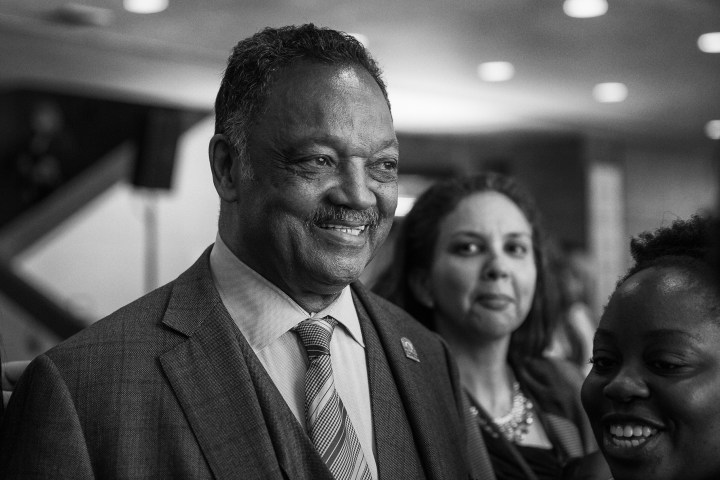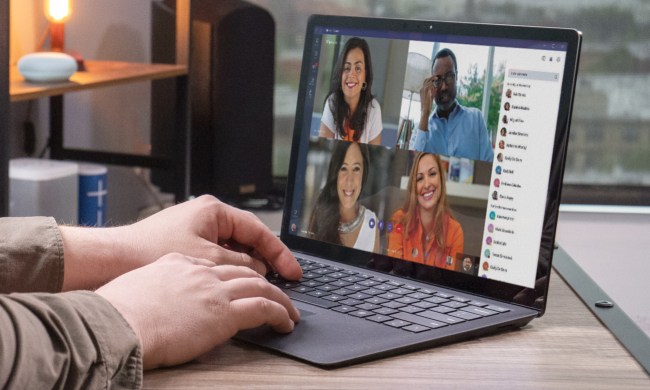
These days, Jackson visits Silicon Valley every month, relentless in his mission to pressure the tech industry into becoming more diverse and accepting of African-Americans, Hispanics, women and other underrepresented groups. He was in Oakland on Thursday, preparing for the second edition of PushTech2020, his series of tech diversity summits, but he often uses these trips to meet with the world’s top tech leaders, including Apple CEO Tim Cook, and question them eye to eye on the status of their diversity efforts and shortcomings.
“It’s really about tech equity, justice and equality.”
Jackson is credited by many as one of the key driving forces behind the tech industry’s push for diversity over the past two years. Going back to the early 2000s, Jackson has tried to make the tech industry more inclusive, but it wasn’t until after purchasing bundles of stock for many of the tech industry’s top companies that his efforts gained traction. Back then, Jackson wanted to see companies like Google, Facebook, and Amazon release their diversity figures so the world could see just how disproportionately women and minorities were being excluded from this industry.
The ice broke, as Jackson puts it, when Google gave in and released its report in May 2014, setting off a domino effect throughout Silicon Valley that has resulted in annual diversity reports from the top tech companies. But for Jackson, diversity reports were just the start.
The civil rights leader has been persistent in this fight, escalating his demands with each passing year. In 2015, Jackson demanded that tech companies provide even more statistics to the public along with the raw EEO-1 workforce documents private companies with more than 100 employees are required to file to the federal government. Jackson also called on the tech industry to bring more diversity to their boards, not just their entry-level positions. Many tech companies failed to comply, but Jackson did manage success on both fronts with Apple, the biggest fish in the tech sea.

With Google’s 2016 diversity report anticipated to arrive no later than June and be followed by the rest of the industry, Jackson is gearing up for the next round of the tech diversity movement. Jackson and his spokesman Butch Wing sat down to chat with Digital Trends.
Digital Trends: Rev. Jackson, this is the second time you’ve hosted the PushTech2020 summit. What is the purpose of this event?
Jesse Jackson: The conference is bringing together people who have an interest in technology and for too long have been disparate and separated. It’s created a critical mass of very talented people who have felt locked out by some common themes. The themes may have been race, lack of access as decision makers or lack of access to capital.
We found that there’s an unbelievable amount of talent being passed over with the idea that there’s a talent crisis when, actually, there was an opportunity crisis.
The tech diversity movement kicked off in May 2014 when Google released its first diversity report. We’re on the verge of entering year three. How would you grade the progress thus far?
JJ: We still have a long way to go. None of the companies have black advertising agencies or, for the most part, law firms, marketing firms, or asset managers, so we’ve begun to make them move on diverse suppliers.
There’s much more ground to be broken. We’ve bought shares of stock at the companies and were persistent in going to shareholders meetings and raising up issues within the context of the leadership, shareholders and the media so as to keep the issue visible. We’re demanding that they be inclusive, not just in Silicon Valley but across the country.
Does the tech industry need to expand its footprint beyond Silicon Valley to achieve true diversity?
JJ: We really need to push to Harlem, to Silicon Forest in the northwest, Austin, Chicago, Atlanta to get more diversity in the field. Tech companies also need to address the historically black colleges and universities, which have become a training ground for blacks in technology more so than the major white universities. You say you can’t find engineers? Well, Hampton, Howard, Morehouse are training them. Beyond that, there are the non-tech areas — lawyers, marketers and advertisers, consultants, manufacturing — where we’re not being included. We’re trying to take off the cultural blinders because people just can’t see the marketplace.

By missing blacks and Latinos and Native Americans, the tech companies are missing money, market, talent, location, and growth. We need to take their blinders off. They’re looking at us through a keyhole rather than through a door. They’re not seeing what we have to offer. We must make bold demands and public demands as consumers, as inventors, as shareholders, and as public policy makers.
You’re saying that when tech companies ignore diversity, they leave money on the table?
JJ: They’re leaving courses uncharted, fields unplowed. We didn’t know what baseball could be until everybody could play. We couldn’t see Jackie Robinson, Hank Aaron, Willie Mays, Barry Bonds. We couldn’t see them, and once the blinders came off, they were judged just by their talent. The same is true in technology. There is not a talent crisis — opportunity crisis. Opportunity to use that which exists and opportunity to build upon that which does not exist.
What are your thoughts on all the young women and minorities who are coming into the tech industry as this movement happens? It must be a daunting task for them.
“This is today’s civil rights struggle: equality. We’re free but not equal.”
JJ: It is, but these young people are already studying STEM fields. They are studying engineering and computer science, as well as the non-tech areas. I keep coming back to lawyers, advertisers, marketers, that whole zone. For now, the areas where they do find work are as cafeteria workers, janitors, secretaries, maids. The fact is that there are more non-tech jobs than tech jobs, and the tech industry for too long has gotten away with not reaching out to the talent that already exists.
One company that has been recently anointed by many in the tech press as an example of a leader in diversity is Slack. This company has released two diversity reports in the past year and recently hired Leslie Miley, the African-American engineer who left Twitter in October while criticizing the company’s lack of diversity.
At the same time, Slack’s own figures show that in the last half of 2015, the company hired just three African-Americans, and yet they’re hailed as a role model for tech diversity …
JJ: Well, we’re not hailing them as that.
So are these companies doing enough to pursue tech diversity?
JJ: No. They should all have a plan to recruit, retrain, maintain, and develop diverse talent as they grow. If not, they grow inherently without inclusion.
Butch Wing: Our goal is not just diversity. Our perspective is: You need diversity in order to get economic justice and equality. Diversity is just a first step in the process to getting full representation. Equality on the board of directors, C-suites, as chairmen, in the workforce — that’s the goal. The goal is not just a vague concept of diversity. It’s really about tech equity, justice and equality.
JJ: All these companies in the technology industry, we pick them to be inclusive based on our consumer spend, our legal strength as citizens, our capacity as workers and as inventors and creators. We demand inclusion.
We don’t want to put them out of business. We want to put justice in business. We don’t come in a hostile way. We come in a determined way. If they react with some plan to delay or deny diversity, they’ll get some confrontation, but that’s a method. Confrontation is not our goal. Inclusion and expansion is our goal.
What more can these companies do?
BW: Companies in Oakland and coming to Oakland should have an Invest-In and Hire Oakland program to fulfill Oakland’s promise. Pandora, which is headquartered in Oakland, should work directly with the community and with the city to hire people in Oakland. They should do this with concrete, measurable, and public goals to hire and to demonstrate their good partnership with the city.
In my reporting, I have found that every time someone like Miley steps up and shares his or her story, the entire conversation around tech diversity is pushed forward and evolves. How important is it that people in positions like Miley speak out?
“To be left behind in tech is to be left behind.”
JJ: It is always important that those within take a position. In 1972, we honored Jackie Robinson, my organization Rainbow Push did, and baseball wasn’t honoring him for the 25th year anniversary of his breakthrough into the sport. Baseball reacted by having him in a ceremony in Cincinnati. His response was, “Thank you, but you don’t have a third-base coach who is black or brown yet.” People within have a certain authority, but they must speak without fear. This is today’s civil rights struggle: equality. We’re free but not equal.
You guys have always demanded more transparency from these tech companies’ diversity reports. What sort of data do you want to see next?
BW: We want to see supplier diversity. A lot of the companies now are setting goals for supplier diversity. Some are beginning to report their spend, but we want them to report specifically, not just the general spend with minority, women and diverse businesses. We want them to report their specific spend with black and Latino businesses and write that out distinctively. If you have $1 billion in spend with diverse businesses and only $10 million of that is with African-American firms, that gives us something that we can use to measure the value of what that program is related to African-Americans and Latinos.
Finally, why do you place such a strong priority on achieving diversity and equality within the tech industry?
JJ: It’s America’s No. 1 growth industry. It’s the encompassing industry of the world today and tomorrow. Right now, what’s driving the whole engine is tech, and to be left behind in tech is to be left behind.




